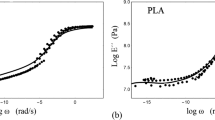Summary
Studies have been made of the viscoelastic behaviour of PVC in the glass-rubber transition by means of square and triangular periodic stresses, in order to find a plausible hypothesis on the appearing molecular mechanisms.
In this respect it is obviously not possible to make a detailed analysis of the different types of mechanisms, based only on results from dynamic mechanical measurements. However, by using the general properties of the function logJ 2 =g α {logJ 1} some ideas can be put forward.
It is apparent that the viscoelastic behaviour stems from more than one single molecular mechanism. “Simple segment movements” dominate the behaviour only in the central part of the transition.
At temperatures around the glass point an increase in losses and/or stiffness appears. It seems possible that this behaviour arises from the influence of the crystallites. At high temperatures a substantial increase in mechanical losses appears, which seems to be due to decomposition of “widely spaced entanglements”.
In the plateau-zone a secondary dispersion appears which shows pronounced sensitivity to the processing conditions. At increased gelation ratio the value of the loss peak increases. As no changes in crystallinity have been observed, it is suggested that this dispersion originates from the decomposition of “untrapped entanglements” outside the network composed by the very small crystallites.
Similar content being viewed by others
References
Jansson, J.-F., J. Appl. Polymer Sci.17, 2965 (1973).
Jansson, J.-F., J. Appl. Polymer Sci.17, 2977 (1973).
Fitzgerald, E. R. andJ. D. Ferry, J. Colloid Sci.8, 1 (1953).
Petersen, J. andB. Rånby, Makromolekulare Chemie133, 251 (1970).
McCrum, N. G., B. E. Read, andG. Williams, Anelastic and Dielectric Effects in Polymeric Solids (New York 1967).
Pezzin, G., G. Ajroldi, T. Casiraghi, C. Garbuglio, andG. Vittadini, J. Appl. Polymer Sci.16, 1839 (1972).
Child, W. C. andJ. D. Ferry, J. Colloid Sci.12, 327 (1957); J. Colloid Sci.12, 389 (1957). —Dannhauser, W., W. C. Child, andJ. D. Ferry, J. Colloid Sci.13, 103 (1958). —Kurath, S. F., T. P. Yin, J. W. Berge, andJ. D. Ferry, J. Colloid Sci.14, 147 (1959).
Ferry, J. D., Viscoelastic Properties of Polymers, Second Edition (New York 1970).
Author information
Authors and Affiliations
Additional information
With 4 figures
Rights and permissions
About this article
Cite this article
Jansson, JF. Superimposed transition mechanisms in polyvinylchloride. Rheol Acta 13, 490–494 (1974). https://doi.org/10.1007/BF01521745
Received:
Issue Date:
DOI: https://doi.org/10.1007/BF01521745



